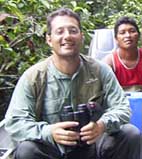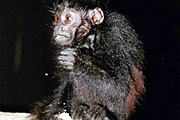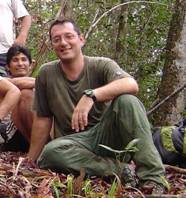New Uakari Photo
Posted by: Loren Coleman on February 6th, 2008

If you’ve been reading of the finding of a new primate in the last few days, you aren’t going crazy if you thought it sounded awfully familiar.
On January 16, 2008, you learned here of the discovery of a new monkey in the Amazon, with the Latin name Cacajao ayresii.
This week various media releases, stimulated by the National Geographic News, have caused a new round of articles. But when I wrote about this new uakari monkey from the Amazon rainforest, there were no photographs available last month. Now I have located photographs of the discoverer (top and below) and Nat Geo has made one of the discovered (directly below) available too.

Cacajao ayresii, black uakari monkey.
For those that need proof that actually searching, a la’ the cryptozoological method, does turn up results, this discovery is one that followed a specific pattern of looking and finding.
Auckland University’s only primatologist Jean Philippe Boubli undertook the first ever study of the black uakari monkey during a series of wildlife surveys after following native Yanomamo Indians on their hunts along the Rio Araca, a tributary of the Rio Negro in Brazil.

Jean Philippe Boubli, (Ph. D., University of California, Berkeley) Auckland University, New Zealand, Senior Lecturer, Department of Anthropology.
“They told us about this black uakari monkey, which was slightly different to the one we knew from Pico de Neblina National Park, where I’d worked earlier,” said Dr. Boubli.
“I searched for that monkey for at least five years. The reason I couldn’t find it was because the place where they were was sort of unexpected.”

The Boubli Lab ~ Primate Field Research Station
“Finding a relatively large monkey as a new species these days is pretty cool,” Dr. Boubli told the National Geographic Magazine.
“It shows how little we really know about the biodiversity of the Amazon.”
About Loren Coleman
Loren Coleman is one of the world’s leading cryptozoologists, some say “the” leading living cryptozoologist. Certainly, he is acknowledged as the current living American researcher and writer who has most popularized cryptozoology in the late 20th and early 21st centuries.
Starting his fieldwork and investigations in 1960, after traveling and trekking extensively in pursuit of cryptozoological mysteries, Coleman began writing to share his experiences in 1969. An honorary member of Ivan T. Sanderson’s Society for the Investigation of the Unexplained in the 1970s, Coleman has been bestowed with similar honorary memberships of the North Idaho College Cryptozoology Club in 1983, and in subsequent years, that of the British Columbia Scientific Cryptozoology Club, CryptoSafari International, and other international organizations. He was also a Life Member and Benefactor of the International Society of Cryptozoology (now-defunct).
Loren Coleman’s daily blog, as a member of the Cryptomundo Team, served as an ongoing avenue of communication for the ever-growing body of cryptozoo news from 2005 through 2013. He returned as an infrequent contributor beginning Halloween week of 2015.
Coleman is the founder in 2003, and current director of the International Cryptozoology Museum in Portland, Maine.










Suppose someone posted that picture of the monkey asking what species it is. How many answers would we have? How many people would assume some type of photoshopping?
That’s a pretty crazy looking monkey though 🙂
To me it looks like a pygmy chimp.
I have a strong sense that many more primates await discovery in the Amazon.
And hopefully one in North America as well… That’s really cool. 🙂
That monkey looks like it has definitely seen bigfoot.
Hello. After visiting this site daily for the last six months, finally registered.
Very Kool!
That is one ugly monkey!
The monkey has a gremlin-like appearance.
Can a North American Ape be far behind??? Even a South American Ape can’t be far behind!!
Congratulations to Dr. Boubli and his support team for this terrific find! Great job!
Let’s hope this discovery serves as a model to other cryptozoologist to persever and to re-asses their model regarding the behavior of the creatures they seek. it’s a bit world and it only seems smaller if you wear blinders.
Props for a great discovery!
I did have to send this picture to my wife. It looks remarkably similar to me first thing in the morning. Scary!
To follow up :: My wife DID agree that the monkey”totally looks just like” me. Thank GOD love is blind!
Once again it took him 5 years to find the primate (I’m assuming that he was in the field most of the 5 years). How can people say that we only need a couple weeks out in the field to get good shots of bigfoot? Ridiculous I say.